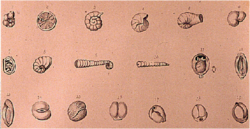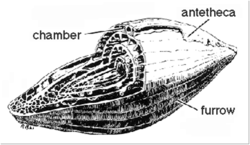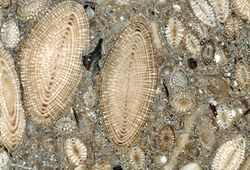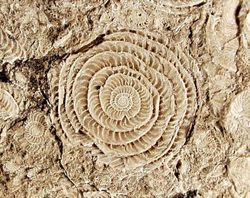Fossils/Protozoa and Chromista
- Main article: Fossils
Protists are organisms that do not fit into any other categories. They are eukaryotic organisms, however they are not animals, plants or fungi. The term "protist" can sometimes cause conflict in biological classification - since protists are more defined by what they are not as opposed to what they are, many protists are more closely related to plants or fungi than other protists. This loose classification means that many biologists consider the term protist obsolete. In modern use, it typically refers to any unicellular eukaryote from amoebas to slime molds.
Only one phylum under Kingdom Protozoa is on the 2020 fossil list - Foraminifera.
Kingdom Protozoa
Phylum Foraminifera (Forams)
This fossil will only be tested at the State and National levels.
| Picture(s) | 
|
|---|---|
| Common Names | Forams |
| Physical Description | Forams are single-celled organisms. Most forams possess a test, a shell secreted while the animal was alive. The shell is commonly made of calcium carbonate (CaCO3) (in the forms of either calcite or aragonite) or aggregated particles of sediment. Tests of chitin are believed to be the most primitive type. Other materials include protein, aggregated particles of sediment, and even silica. Tests may or may not be divided into multiple chambers and range from a simple sphere/tube with an aperture (opening) at the end to complex arrangements of chambers. Forams possess reticulopodia, which are formations of pseudopodia in irregular nets, designed for catching food or food ingestion with a secondary function of locomotion. Pseudopodia are cytoplasm-filled, thread-like projections of the cell membrane. Reticulopodia are also called myxopodia. The holes that connect chambers and allow the pseudopodia to come out of the test are called foramen, Latin for “window.” Forams can range in size from diameters smaller than one millimeter to diameters up to two hundred times that. However, most species of foram are smaller than one millimeter. |
| Fossil Range | Early Cambrian (probably earlier) to present-day. |
| Taxonomy | Phylum: Retaria Subphylum: Foraminifera |
| Mode of Life or Habitat | Forams are generally aquatic, and the majority were benthic while some were planktonic. Less commonly, they lived in freshwater or brackish environments. A very small number lived in soil. Some are epifaunal (living on the surface of the sea/lake bottom) and some are infaunal (living beneath the surface). Most forams are heterotrophic, using suspension feeding to feed on phytoplankton or diatoms. Some prey on small crustaceans. Some prey on other forams. Some are parasitic. |
| Adaptations Over Time | While fossilized forams are typically very small (less than 20 cm), larger forams with complex shell structures have been found over time. Over time, their tests slowly became harder. |
| Etymology | Foraminifera is Latin for "hole-bearer." |
| Additional Information | Due to their hard shells, forams are easily preserved. Forams became much more common when coral reefs expanded, and would die off without them. For this reason, they are good bioindicators. Forams are also useful indicators of past environments and can be good index fossils. The petroleum industry will typically analyze the foram content of the ground they want to drill in to determine whether or not to drill there. In the phylum Foraminifera, competitors must know the order Fusulinida and the genus Nummulites. In some circles, Foraminifera is considered a class or a sub-phylum to the phylum Retaria. |
| External Links | https://en.wikipedia.org/wiki/Foraminifera. https://www.bgs.ac.uk/discovering-geology/fossils-and-geological-time/foraminifera/. |
Order Fusulinida (Fusulinids)
This fossil will only be tested at the State and National levels.
| Picture(s) | 
|
|---|---|
| Common Names | Fusulinids (however, this is often applied to just Fusulinacea and not the whole order) |
| Physical Description | As the test grows, it twists into a spiral around the single cell and forms chambers. They look similar to grains of wheat, and many of them are found together. |
| Fossil Range | Upper Pennsylvanian to Upper Permian, 318-251 mya. Went extinct in the P-T extinction. |
| Taxonomy | Domain: Eukaryota Phylum: Retaria Subphylum: Foraminifera |
| Mode of Life or Habitat | Most were planktonic, living in clear marine water far from shore. |
| Adaptations Over Time | Early fusulinids were smaller and more spherical, and overtime they evolved to be longer and narrower. |
| Distribution | Fusulinids have been found on every continent except for Antarctica, though they are especially common in eastern Kansas. |
| Additional Information | Fusulinids have also been considered a genus instead of an order in some classifications. They are some of the most complex forams. Fusulinids were omnivorous, eating via reticulopodia (cell extensions), which projected through pores in the test to catch small creatures. The shell is secreted by the protoplasm of the cell. Fusulinids went extinct with the Permian-Triassic extinction event, making it a good index fossil. |
| External Links | https://en.wikipedia.org/wiki/Fusulinida. |
Order Rotaliida
This fossil will only be tested at the State and National levels.
| Picture(s) | 
|
|---|---|
| Physical Description | All members of this order have tests made of calcite with multiple small cavities. They can be anywhere from simple to complex, with some organisms having many subdivisions and others with none at all. |
| Fossil Range | Triassic to Recent |
| Taxonomy | Phylum: Retaria Subphylum: Foraminifera Class: Globothalamea |
| Mode of Life or Habitat | Organisms in Rotaliida are typically benthic, though some may be found in estuaries. |
| Adaptations Over Time | Many members of this order have incredibly diverse tests depending on their environment. Tests can be smooth or marked, with some having small dots on the outside and others having large defensive spikes. Some tests may also have internal canals or other complex systems. |
| Distribution | Rotaliida can be found in any marine environment where Foraminifera are found. |
| Additional Information | Rotaliida may also be known as Buliminida in some writings. |
| External Links | https://en.wikipedia.org/wiki/Rotaliida. |
Genus Nummulites
This fossil will only be tested at the State and National levels.
| Picture(s) | 
|
|---|---|
| Physical Description | The test of Nummulites is also spiraled, but does not form the same structure as that of Fusulinida - it instead takes the shape of a disc. Extremely large for a foram, species in this genus can reach up to six centimeters in diameter. |
| Fossil Range | Late Cretaceous (85.8 mya) to modern-day, but are most commonly found from the Eocene Epoch (54-35 mya); medium-sized Nummulites only came from the Middle Eocene. |
| Taxonomy | Phylum: Retaria Subphylum: Foraminifera Order: Rotaliida |
| Mode of Life or Habitat | Nummulites are benthopelagic, living and feeding at the bottom of the ocean's photic zone. |
| Distribution | Nummulites fossils can be found in the Middle East, North Africa, Europe, and Asia. They are most frequently found in southwest Asia and the Mediterranean, however. |
| Etymology | Nummulites means "little coin" in Latin. |
| Additional Information | Limestone containing Nummulites was used to build the Pyramids of Giza. Ancient Egyptians used Nummulites as coins. |
| External Links | https://en.wikipedia.org/wiki/Nummulite. |

